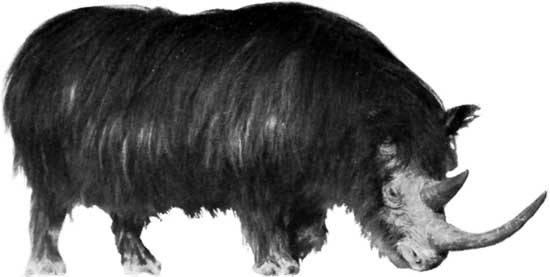woolly rhinoceros
 extinct species of rhinoceros found in fossil deposits of the Pleistocene Epoch (1.8 million to 11,800 years ago) in Europe, North Africa, and Asia. It probably evolved from an earlier form, Dicerorhinus, somewhere in northeastern Asia, entered the European region, and became extinct at the end of the most recent ice age. Frozen carcasses of woolly rhinoceroses have been found preserved in Siberia, and others have been found well preserved in oil (petroleum) seeps in central Europe. The animal was massive, with two large horns toward the front of the skull, and covered with a thick coat of hair.
extinct species of rhinoceros found in fossil deposits of the Pleistocene Epoch (1.8 million to 11,800 years ago) in Europe, North Africa, and Asia. It probably evolved from an earlier form, Dicerorhinus, somewhere in northeastern Asia, entered the European region, and became extinct at the end of the most recent ice age. Frozen carcasses of woolly rhinoceroses have been found preserved in Siberia, and others have been found well preserved in oil (petroleum) seeps in central Europe. The animal was massive, with two large horns toward the front of the skull, and covered with a thick coat of hair.The woolly rhinoceros was also present in more temperate, nonglacial regions, where it inhabited grasslands (grassland). It was a popular subject for Stone Age painters and sculptors; their representations of the woolly rhinoceros, some of which are very accurate, are known from several localities.
- Serpotta, Giacomo
- Serpukhov
- Serpukhovian Stage
- Serra do Mar
- Serra, Junípero, Blessed
- Serrano
- Serrano, Andres
- Serrano y Domínguez, Francisco, duque de la Torre
- Serra, Richard
- Serravalle
- Serravallian Stage
- Serre, Jean-Pierre
- Sert, José Luis
- Sertorius, Quintus
- Sert y Badia, José María
- sertão
- serum
- serum albumin
- serum sickness
- serval
- Servandoni, Giovanni Niccolò
- Servan-Schreiber, Jean-Jacques
- Servants of India Society
- Servetus, Michael
- service club